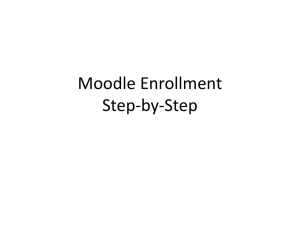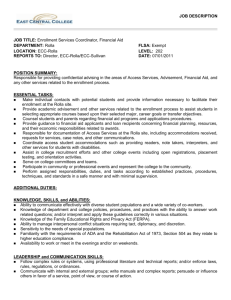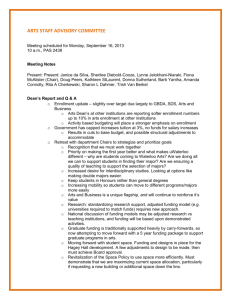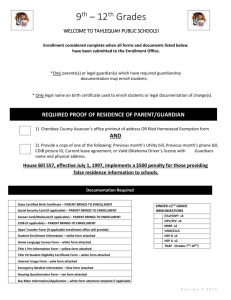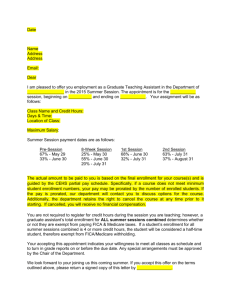A4 - Skyline College
advertisement
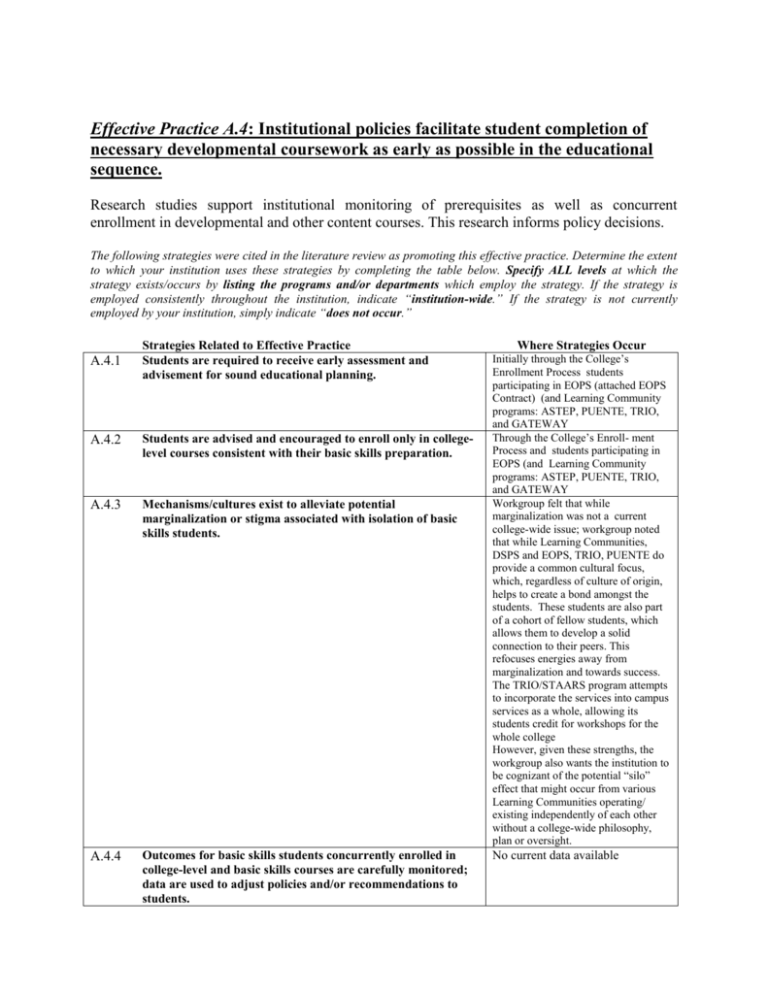
Effective Practice A.4: Institutional policies facilitate student completion of necessary developmental coursework as early as possible in the educational sequence. Research studies support institutional monitoring of prerequisites as well as concurrent enrollment in developmental and other content courses. This research informs policy decisions. The following strategies were cited in the literature review as promoting this effective practice. Determine the extent to which your institution uses these strategies by completing the table below. Specify ALL levels at which the strategy exists/occurs by listing the programs and/or departments which employ the strategy. If the strategy is employed consistently throughout the institution, indicate “institution-wide.” If the strategy is not currently employed by your institution, simply indicate “does not occur.” A.4.1 Strategies Related to Effective Practice Students are required to receive early assessment and advisement for sound educational planning. A.4.2 Students are advised and encouraged to enroll only in collegelevel courses consistent with their basic skills preparation. A.4.3 Mechanisms/cultures exist to alleviate potential marginalization or stigma associated with isolation of basic skills students. A.4.4 Outcomes for basic skills students concurrently enrolled in college-level and basic skills courses are carefully monitored; data are used to adjust policies and/or recommendations to students. Where Strategies Occur Initially through the College’s Enrollment Process students participating in EOPS (attached EOPS Contract) (and Learning Community programs: ASTEP, PUENTE, TRIO, and GATEWAY Through the College’s Enroll- ment Process and students participating in EOPS (and Learning Community programs: ASTEP, PUENTE, TRIO, and GATEWAY Workgroup felt that while marginalization was not a current college-wide issue; workgroup noted that while Learning Communities, DSPS and EOPS, TRIO, PUENTE do provide a common cultural focus, which, regardless of culture of origin, helps to create a bond amongst the students. These students are also part of a cohort of fellow students, which allows them to develop a solid connection to their peers. This refocuses energies away from marginalization and towards success. The TRIO/STAARS program attempts to incorporate the services into campus services as a whole, allowing its students credit for workshops for the whole college However, given these strengths, the workgroup also wants the institution to be cognizant of the potential “silo” effect that might occur from various Learning Communities operating/ existing independently of each other without a college-wide philosophy, plan or oversight. No current data available As applicable, briefly describe how this practice occurs/exists at your institution: What evidence exists to support the efficacy of this practice? What barriers/limitations exist to implementing or enhancing this practice? How might this practice be advanced or expanded upon in the future? A.4.1: Students are required to receive early assessment and advisement for sound educational planning. Skyline College follows the “district model” policy and procedure for implementing the Matriculation (Enrollment) process that allows students who have a self-identified educational goal be provided special college services following the application process. All new Students are provided (A.4.1) “early” assessment and advisement for sound educational planning through a four (4) step component process. These components are college services and activities identified as: Admissions, Orientation, Assessment, and Counseling/Advisement. Once the student completes the college’s application process, the student is provided with an “enrollment ticket” that both informs and guides the student through the remaining steps of the college’s enrollment process. When the student completes each “enrollment process or component”, college staff will “stamp” their enrollment ticket to indicate completion of that step. Another goal and purpose of the enrollment ticket is to facilitate the student moving through and completing the enrollment process as early as possible and with little delay so that the student can enroll in the appropriate courses in a timely manner. A new student cannot enroll in courses until they complete the enrollment process. Once their completed enrollment “ticket” has been submitted to admissions, the student will be allowed to enroll in courses. The enrollment steps (activities) are closely linked and scheduled to allow students to achieve “early assessment and advisement for sound educational planning with minimal delay. A.4.2: Students are advised and encouraged to enroll only in college-level courses consistent with their basic skills preparation. Counseling/Advisement Component Skyline College makes appropriate referral(s) to available support services and curriculum offerings based on the student placement results. As part of the New Student Enrollment Process, all “new” students cannot enroll in classes until they meet with a counselor, which is the last step of the enrollment process. When determining course selection; counselors strongly advise and encourage students to enroll in “college-level” courses consistent with their basic skills preparation. Counseling course recommendations are outlined in a student educational based on the student’s goal and placement results. In addition, the College makes reasonable efforts to ensure that probationary non-exempt students participate in counseling, including required participation in a student success program and limited enrollment based on probationary status. The college makes reasonable efforts to ensure that non-exempt students without a declared educational goal participate in counseling. The college makes reasonable efforts to ensure that nonexempt students enrolled in pre-collegiate basic skills courses participate in counseling or advisement; and that counseling or advisement is available to all non-exempt students. The college provides assistance in selection of a specific educational goal and development of the student educational plan, including student responsibilities. The college maintains a copy of the student educational plan in written or electronic form and reviews, and when necessary, updates or revises, the student educational plan, its implementation, and its accuracy related to students’ needs. The college provides modified or alternative services for the matriculation process (if necessary) for ethnic and language minority students and students with disabilities. Students, who are exempted, are made aware through written and electronic means that they may choose whether or not to participate in this component and ensures that exemptions from this component are not based upon specified sole criterion. Strategy: A.4.3 Mechanisms/cultures exist to alleviate potential marginalization or stigma associated with isolation of basic skills students. Where Strategy Occurs: Disabled Students Program & Services (DSPS), the Puente Project, TRIO/STAARS, the English for Speakers of Other Languages (ESOL) department As applicable, briefly describe how this practice occurs/exists at your institution. DSPS calls its program “Differential Learning Skills” to try to take the stigma away from disability. In the Puente Project, there seems to be less marginalization due to a common cultural focus, which, regardless of culture of origin, helps to create a bond amongst the students. These students are also part of a cohort of fellow students in a Learning Community, which allows them to develop a solid connection to their peers. This refocuses energies away from marginalization and towards success. The TRIO/STAARS program attempts to incorporate the services into campus services as a whole, allowing its students credit for workshops for the whole college. In addition, STAARS/TRIO gives its students priority for tutoring services, which provides a sense of benefit rather than stigma. The program is also open to students that are not at the basic skills level, such as low-income, firstgeneration college students that have an educational need. In this way, the program minimizes the stigma of being specifically a program for basic skills. The ESL program calls itself English for Speakers of Other Languages, and many of its ancillary classes carry the term “for Nonnative Speakers” instead of the traditional English as a Second Language name (which can cause confusion among long-term learners or speakers of multiple languages). Finally, the Basic Skills lab advertises its services using general, active, academic terms such as “For help with… Identifying and correcting grammar errors; Fixing difficulties with punctuation; Locating and fixing spelling errors; Improving the complexity and clarity of sentences; and Learning to better proofread and edit your writing” that would appeal to both basic and advanced students. What evidence exists to support the efficacy of this practice? It is unclear exactly how effective these practices are, but the following programs are wellenrolled and highly regarded as evidenced by exit surveys of students: DSPS ESOL TRIO/STAARS Puente What barriers/limitations exist to implementing or enhancing this practice? The terms used for such stigmatized areas as “Basic Skills,” “ESL,” and “Disabled” are difficult to paraphrase without losing the actual meaning of the discipline. However, the attempts that have been made to remove stigmatizing language appear to be successful. The only program not showing overwhelming enrollment is the Basic Skills lab, which is in its first year and still being advertised. It is difficult to estimate the reasons for low enrollment so early in its foundation. How might this practice be advanced or expanded upon in the future? Further surveys of students are needed to ensure good regard of the programs. However, a more telling marker would be to better integrate these programs into the college so as to provide a seamless flow from basic skills coursework into college-level coursework. The stigma of being labeled “ESL,” for example, could be alleviated by a closer partnership with foreign language and the emphasis on the benefits of being multilingual; also, a campaign highlighting language skill levels needed in particular vocational fields (and perhaps the potential salaries of successful candidates) could recast English language learning as a step on par with general education coursework rather than an obstacle to it. Perhaps the term “Basic Skills” could be termed as something directly connected to academic success instead of something incongruous in an institution of higher learning. Effective Practice A.4 Strategy: A.4.4 Outcomes for basic skills students concurrently enrolled in college-level and basic skills courses are carefully monitored; data are used to adjust policies and/or recommendations to students. Where Strategy Occurs: The Office of Planning, Research and Institutional Effectiveness (PRIE) TRIO/STAARS DSPS Puente Project EOPS/CARE As applicable, briefly describe how this practice occurs/exists at your institution. The Office of Planning, Research and Institutional Effectiveness (PRIE) has an annual report that goes to the high schools on Skyline’s concurrently enrolled students. The report includes enrollment, placement information and success and retention information. The success and retention information is aggregate (by all courses not broken out by basic skills). The state Chancellor’s Office also provides an annual report (ARCC) that Skyline uses which provides data on basic skills students (Basic Skills Improvement Rates). Skyline also does some ad hoc studies to track these students, but nothing on a systematic basis. The TRIO/STAARS, DSPS, EOPS and Puente Project do track students’ progress as long as the student remains in these respective programs; they do this via regular grade reports and individual counseling sessions. No systemic tracking is done with these students once they leave these programs except for limited research done on an ad hoc basis by the PRIE, mentioned above. In the EOPS/CARE program, a viable, strong and well organized “case management” approach is used to identify, track, monitor and follow through on individual students who elect to participate in the EOPS/CARE program. Students must agree to a specific list of activities, requirements, and conditions to not only participate in the EOPS/CARE program but to receive the services and benefits the program affords students who meet the state mandated criteria. Students must sign a contract (Mutual Responsibility Contract) that outlines the responsibilities and conditions the student must agree to. What evidence exists to support the efficacy of this practice? Some of the limited research that has been done on basic skills has been used to make adjustments to programs and services as well as measuring the overall college-wide performance. For example, the College has created a Balanced Scorecard which allows it to measure its effectiveness in all areas of operation, and the data regarding Basic Skills on this scorecard is a result of such research. All basic skills programs utilize some form of student satisfaction survey which is taken into account during times of program revision, but there is no possibility to use extensive tracking data regularly to adjust policies in these programs. What barriers/limitations exist to implementing or enhancing this practice? The PRIE has limited resources for institutional research. The office is not fully staffed to do extensive research in basic skills, and what it does is somewhat limited. Individual programs such as TRIO/STAARS and Puente have only part-time coordinator funding, and there is not enough staff to initiate and manage data tracking. EOPS has full time staffing but no appropriate staff to initiate and manage data tracking. How might this practice be advanced or expanded upon in the future? The college will need to make some decisions about prioritizing research so that resources may be used efficiently. The PRIE is staffed by one director of research and one research analyst, so the ability to conduct extensive research is limited. It is also recommended that general education programs and basic skills programs come together to better integrate with each other and to clarify the expectations of skills needed for transfer-level courses. It is vital that each basic skills program show exactly how it is impacting student success in related coursework, and this evidence must be used to evaluate the programs themselves so that improvements can be made. If a tracking pathway can be created, and if programs can access the data, improvements to the services can be made on a larger scale and have significant impact upon retention in general education and transfer courses. Planning Matrix for Section A - Organizational and Administrative Practices For each planned action, indicate which effective practice and strategy it is related to; if the strategy is a local one, not identified in the literature, then indicate the effective practice's number followed by "local." Indicate whether the action is new, a change (substantially altering a program or practice in order to be more effective), or an expansion (expanding an existing program or practice to meet the needs of a greater number of students and/or employees). Section New, Current Change, Measure of or Effectiveness Effective Practice Expansio (Baseline) Planned Action and Strategy n Start Date Add more sections of Basic Skills A.4.2 No current New 9/07 Section A Organizational/ Administrative Practices courses, especially ESOL so that encouraged & advised students will enough BS courses to enroll in. Conduct studies of students in BS courses and their transition into degree and transfer level courses. effort in place Projected Measure (Benchmark) Date for Projected Measure Responsibility Half of college employees access annual newsletter as indicated by "hits" to newsletter website. Jan 2008 Instruction Fall 2008 Instruction & Research A.4.4 New 8/08 No current effort in place Persistence/Success rates With collected data/research coordinate the proper alignment of BS courses to enhance student success A.4.4 Expansi on 8/08 No current effort in place Persistence/Success rates Create a student friendly class schedule that would schedule courses (and learning communities) based on time/learning community/theme/major/etc and/or recommended course pairings rather than based on the traditional (alpha) instructional format. Create a class schedule the way the student would use it. Provide additional assessments and counseling/ advising services at the high school (9-12 grades) to prepare students successfully for transition to college. (Part of larger expanded outreach program w/high schools) A.4.2 (maybe A.4.3) New F/08 None Students would enroll in more appropriate course parings based on major, BS level, interests, and time. Jan 09 and/or May, 09 Instruction and Student Services A.4.1 and A.4.2 Expansi on Pilot in S08; Current: 50%+ students scoring at BS skill level courses and “undecided” as to ed goal Students would be more college prepared: high placements results, more clearly stated ed goals; successful transition to college Every semester Student Services Instruction/ Research Budget Priority Request FTE driven Institute a college outreach activity that integrates assessment, orientation, and advising (as Intro to College Course) in to a Social Science course co-taught by high school and Skyline College counselor (Course could be part of the 9th grade curriculum. ) A.4.1, A.4.2, A.4.4 New Pilot in F08 Begin preparing high school students for the college through academic and psychological transitional activities & strategies Expect students to increase graduation rates from high school; start college with declared goal; students would begin college with an improved academic and psychological point. Help w/concurrent enrollment process from 9th grade on. Develop a policy, plan and organizational structure that will allow for independent Learning Communities to co-exist, yet provide un-duplicated services to the students being served within/across the programs. A.4.4 New F08 Improved communication and integration of services so that duplication and better use of staffing, services, and support; students would not be confused Students would be case managed across programs; meet each semester; student progress tracked Every semester Student Services



